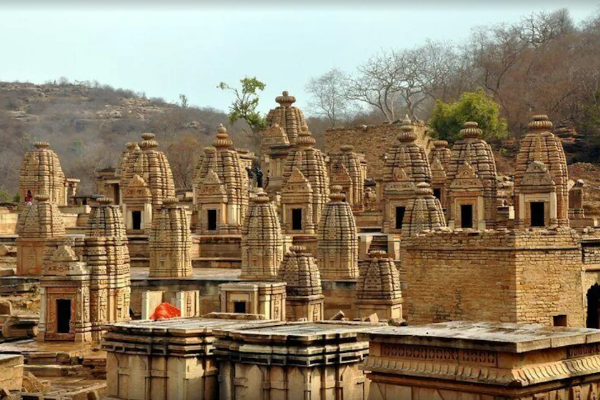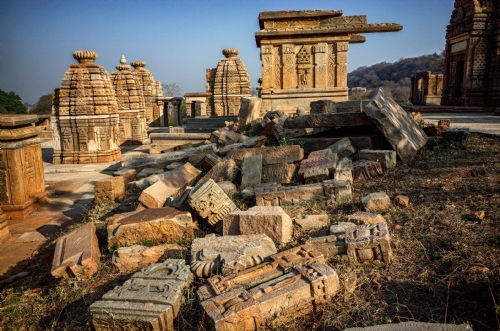Bateshwar: the restored glory of ancient 200 temples!
This group of 200 temples was built during the reign of Gurjara-Pratihara dynasty & the temples here are dedicated to Lord Shiva, Vishnu and Shakti
Total Views |
Today, let us explore one of the most unique temple complexes situated in India. Will you believe if we tell you that an archaeologist was able piece together almost an entire site of 200 Temples which was in ruins - with its pieces, small & large, scattered all over the site? The Bateshwar Temple is a group of Hindu ancient temples, situated about 30 kms from the city of Morena, Gwalior, in Madhya Pradesh. The temple complex is spread over around 25 acres of land.

Over the course of a decade, Mohammed and his team were able to reassemble 60-80 of the estimated 200 temples that originally stood there. These temples are now easily accessible for the public to explore.

According to Gerd Mevissen, the Bateshwar temple complex has many interesting lintels, such as one with Navagraha, many with Dashavatara of the Vaishnavism tradition, frequent display of Saptamatrikas (seven mothers) from Shaktism tradition. Presence of Navagraha lintel suggests, states Mevissen, that the temple complex must be dated post 600 CE.

According to MP’s Archaeology Directorate, this group of 200 temples was built during the reign of Gurjara-Pratihara dynasty. It is believed that all these temples here are dedicated to Lord Shiva, Vishnu and Shakti. Several statues of deities can also be seen on the walls of these temples.
The area is within the fort of Chambal River valley. Lord Shiva’s temple is the largest temple in this group of temples here. Local people know this Shiva temple by name as Bhuteshwar. The temple is also called the Batesvar / Batesara Temple site. These temples were destroyed in the 13th century, but the reason for it is still in the debates.
🌱Resurgence🌱
— Darshana 🇮🇳 (@We_The_Saffron) May 14, 2020
'Rebirth of Bateswar'🌄
Bateswar temples are a group of nearly 200 sandstone temples & their ruins in chambal Valley, M.P. in post-Gupta, early Gurjar-Pratihara style of North Indian temple architecture. They are dedicated to Shiva, Vishnu and Shakti. pic.twitter.com/0PtyjYTHhS
History | This collection of Hindu temples is believed to have been constructed between the 8th and 10th centuries by Gurjara-Pratihara dynasty. Little is known about their construction, as once this empire fell, the temples too disappeared from the history books, and were swallowed up by the jungle. They were re-discovered by British archeologist Alexander Cunningham, in the 19th-century. But by then, these temples were in ruins. Historians believe that an earthquake during the 13th-century was responsible for this destruction.
Despite it being declared a protected site by the Archeological Survey of India (ASI) in 1920, the temple complex remained in this ruined state for the entire 20th-century. The local dacoits / gangs once controlled the area surrounding the temples, thus preventing tourists and archaeologists from visiting this site. On the bright side, this also meant that the vandals were unable to enter here either.
Also Read | Undavalli Caves, where faiths merge!
Restoration | In 2002, renowned ASI archaeologist, K.K. Mohammed, obtained permission from the local dacoit leader to begin restoration efforts. The ambitious project called for collect all the ruins, reassemble them, and restore as many of them as possible. The task was immensely daunting, as the entire temple complex was broken into thousands of pieces, just like an ancient jigsaw puzzle.
Over the course of a decade, Mohammed and his team were able to reassemble 60-80 of the estimated 200 temples that originally stood there. These temples are now easily accessible for the public to explore.

Muhammed said that he could complete major restoration work of Bateshwar with just Rs 2 crore. The ASI restored 80 of the 200 that existed there & the work on another 40 is half complete. According to Muhammed, the Bateshwar complex was "built on the architectural principles enunciated in two Sanskrit Hindu temple architecture texts, Manasara Shilpa Shastra composed in the 4th century CE & Mayamata Vastu Shastra written in the 7th century CE". He followed these texts as his team of over 50 workers collected pieces of ruins from the site, and like a jigsaw puzzle tried to put it back together.
Also Read | Angkor Wat, the largest temple complex in the world dedicated to Vishnu
The carvings on these temples are truly intricate even for their age. Some evoking similarities with the more well-known Khajuraho temples. They stand as a half-finished masterpiece, as dozens of small temples are surrounded by ruins of their yet-to-be-reconstructed siblings. It’s rare to find so many temples concentrated in such a small area. The lack of visitors does give the site an eerie & abandoned feel.
According to Gerd Mevissen, the Bateshwar temple complex has many interesting lintels, such as one with Navagraha, many with Dashavatara of the Vaishnavism tradition, frequent display of Saptamatrikas (seven mothers) from Shaktism tradition. Presence of Navagraha lintel suggests, states Mevissen, that the temple complex must be dated post 600 CE.


